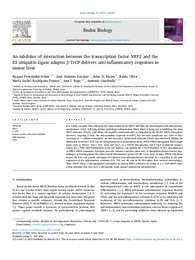Resumen :
It is widely accepted that activating the transcription factor NRF2 will blast the physiological anti-inflammatory
mechanisms, which will help combat pathologic inflammation. Much effort is being put in inhibiting the main
NRF2 repressor, KEAP1, with either electrophilic small molecules or disrupters of the KEAP1/NRF2 interaction.
However, targeting β-TrCP, the non-canonical repressor of NRF2, has not been considered yet. After in silico
screening of ~1 million compounds, we now describe a novel small molecule, PHAR, that selectively inhibits the
interaction between β-TrCP and the phosphodegron in transcription factor NRF2. PHAR upregulates NRF2-target
genes such as Hmox1, Nqo1, Gclc, Gclm and Aox1, in a KEAP1-independent, but β-TrCP dependent manner,
breaks the β-TrCP/NRF2 interaction in the cell nucleus, and inhibits the β-TrCP-mediated in vitro ubiquitination
of NRF2. PHAR attenuates hydrogen peroxide induced oxidative stress and, in lipopolysaccharide-treated macrophages,
it downregulates the expression of inflammatory genes Il1b, Il6, Cox2, Nos2. In mice, PHAR selectively
targets the liver and greatly attenuates LPS-induced liver inflammation as indicated by a reduction in the gene
expression of the inflammatory cytokines Il1b, TNf, and Il6, and in F4/80-stained liver resident macrophages.
Thus, PHAR offers a still unexplored alternative to current NRF2 activators by acting as a β-TrCP/NRF2 interaction inhibitor that may have a therapeutic value against undesirable inflammation.
|
 La licencia se describe como: Atribución-NonComercial-NoDerivada 4.0 Internacional.
La licencia se describe como: Atribución-NonComercial-NoDerivada 4.0 Internacional.
.png)
